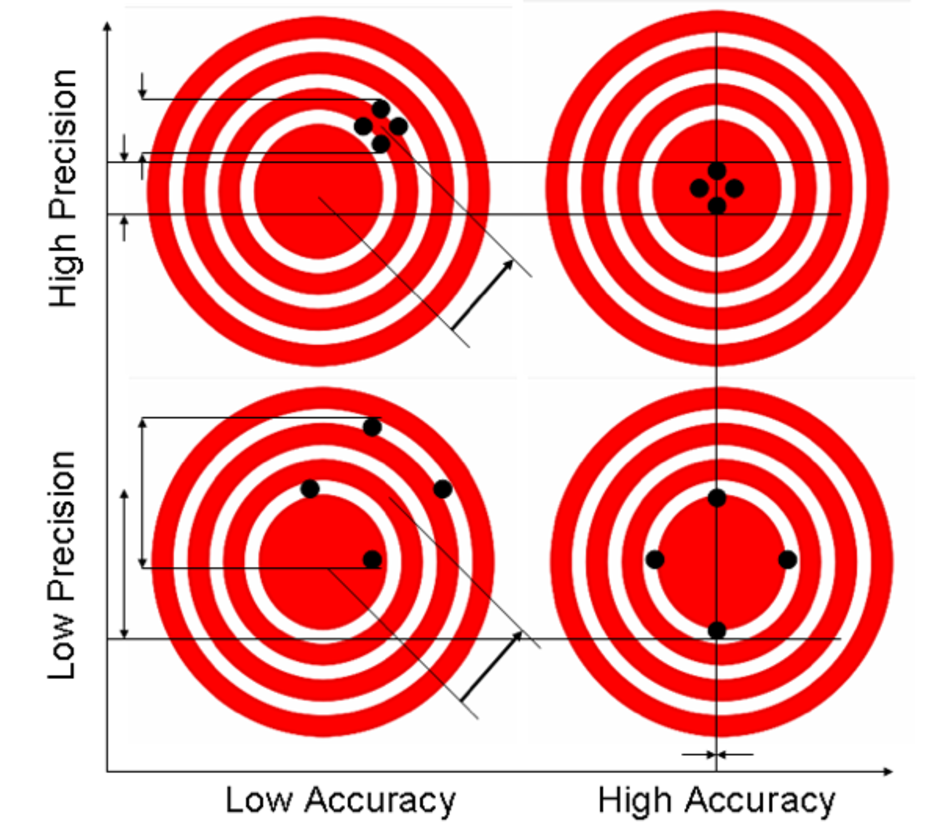Accuracy and Precision

http://en.wikipedia.org/wiki/File:Accuracy_and_precision.svg
ถ้า Accuracy มีมาก
สิ่งที่ได้จะไม่ห่างไปจากสี่งที่ต้องการ
เทียบได้กับ การลด Sysrematic Error หรือ การลด Bias
ด้วยการออกแบบการวิจัย Methodology และ Study Design ให้เหมาะสม
เช่น เครื่องชั่งน้ำหนักสปริงอ่อนไป 1 กิโลกรัม น้ำหนักที่บันทึกไว้จึงน้อยไปทุกคน
หรือ ติดแถบวัดส่วนสูง สูงจากพื้นไป 1 เซนติเมตร ส่วนสูงที่บันทึกไว้จึงน้อยไปทุกคน
ส่วน Precision คือ Range ของการวัด มีความกว้างมากหรือไม่
ถ้า Precision มีมาก Range ของการวัดจะมีค่าน้อย ไม่แก่วงไปมาซ้ายขวา
เทียบได้กับ การลด Random Error

Precision is sometimes stratified into:
- Repeatability — the variation arising when all efforts are made to keep conditions constant by using the same instrument and operator, and repeating during a short time period; and
- Reproducibility — the variation arising using the same measurement process among different instruments and operators, and over longer time periods.
Precision อาจจำแนกออกเป็น
Repeatability คือทำวิธีการเดิม
เครื่องมือชุดเดิม เจ้าหน้าที่ Lab คนเดิม
เช่น Lab ที่ โรงพยาบาลรามาธิบดี ตามเดิม
Reproducibility คือทำวิธีการเดิม
เครื่องมือชุดใหม่ เจ้าหน้าที่ Lab คนใหม่
เช่น Lab ที่ โรงพยาบาลศิริราช Lab ที่ โรงพยาบาลจุฬ่า
ถ้าหากผู้เก็บ Specimen เก็บตัวอย่างผิดวิธี ผิดเวลา ใส่ Media
ผิดชนิด
เก็บไว้ในตู้เย็นหรือแช่น้าแข็งแทนที่จะเป็นเก็บไว้ในอุณหภูมห้อง
หรือว่าสลับกัน ก็อาจไม่เคยตรวจได้ผลบวกเลย ได้ผล Negative
ทั้งหมด
ถ้าหากผู้เก็บ Specimen เก็บตัวอย่างแล้ว Contaminate ที่ ผู้เก็บ
หรือ Contaminate ที่ห้อง Lab
ก็อาจได้ผลบวกหลาย ๆ ตัวอย่างได้
"Accuracy" is also used as a statistical measure of how well a binary classification test correctly identifies or excludes a condition.
|
Condition (e.g. Disease) As determined by "Gold" standard |
||||
| True | False | |||
| Test outcome |
Positive | True Positive | False Positive | → Positive Predictive Value |
| Negative | False Negative | True Negative | → Negative Predictive Value | |
| ↓ Sensitivity |
↓ Specificity |
Accuracy | ||
TP = True Positive
FP = False Positive
TN = True Negative
FN = False Nagative
Accuracy = (TP+TN) / (TP+FP+TN+FN)
Precision = TP /
(TP+FP)
That is, the accuracy is the proportion of true results (both
true positives and true
negatives) in the population. It is a parameter of the
test.
On the other hand, precision is defined as the proportion of the
true positives against all the positive results
(both true positives and false positives)
ถ้า Systematic Error (Bias) มีน้อยลง
Accuracy จะมากขึ้น
ถ้า Random Error มีน้อยลง Precision
จะมากขึ้น

Accuracy is a qualitative term
referring to whether there is agreement between a measurement made
on an object and its true (target or reference) value. Bias is a
quantitative term describing the difference between the average of
measurements made on the same object and its true value. In
particular, for a measurement laboratory, bias is the difference
(generally unknown) between a laboratory's average value (over
time) for a test item and the average that would be achieved by the
reference laboratory if it undertook the same measurements on the
same test item.
http://www.itl.nist.gov/div898/handbook/mpc/section1/mpc113.htm
Examples of systematic errors would be time measurements by a
clock that runs too fast or slow, distance measurements by an
inaccurately marked meter stick, current measurements by
inaccurately calibrated ammeters, etc.
Generally speaking, systematic errors are hard to identify with a
single experiment. In cases where it is important, systematic
errors may be isolated by performing experiments using different
procedures and comparing results. If the procedures are truly
different, the systematic errors should also be different and
hopefully easily identified. An experiment that has very
small sytematic errors is said to
have a high degree of accuracy.
Random errors are a whole different bag. These errors are produced
by any one of a number of unpredictable and unknown variations in
the experiment. Examples might include fluctuations in room
temperature, fluctuations in line voltage, mechanical vibrations,
cosmic rays, etc. Experiments with very small
random errors are said to have a high degree of
precision. Since random errors produce variations
both above and below some average value, we may Generally quantify
their significance using statistical techniques.
http://www.phy.ilstu.edu/slh/Errors.pdf
Linkto: Screening Test, Sensitivity, Specificity, PPV, NPV. ROC
Curve
http://www.health.nu.ac.th/screen/index.htm
Linkto: Blog EPISTAT
http://gotoknow.org/blog/epistat
Linkto: Blog Nopadol
http://gotoknow.org/blog/nopadol
ความเห็น (0)
ไม่มีความเห็น